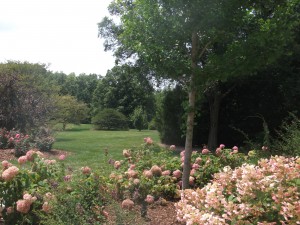Chicago is not terribly old, as world-class cities go. It was incorporated only in 1837. The area was essentially devoid of European settlers until the 19th century. In the preceding centuries, the resident Indians, including the Potawatomi, had created a landscape dominated by oak ecosystems as a result of actively managing the landscape through the use of prairie fires. On the open lands of the Upper Midwest, there were few meaningful fire breaks, and the fires drifted east over vast grasslands. This North American fire regime changed the land by preventing the establishment of woody species, allowing oaks to dominate because of their thick, fire-resistant barks. The oaks in turn allowed more sunlight through their canopy and provided a thriving ecosystem for numerous species, including more than 800 species of birds and moths that eat their leaves.
The settlers who arrived in the 19th century, however, whether wittingly or otherwise, made quick work of the landscape they inherited from the natives they largely pushed out. They suppressed the wildfires in favor of plowing the prairie soils and savannas to create farm fields. Natural wildfires are few in northern Illinois; the wildfires that preceded European settlement were almost entirely a native artifact, which served the purpose of clearing hunting grounds but also served natural purposes of preparing the land for the sprouting of prairie plants. As the oaks receded, other trees moved into the void where fields did not prevent them, and in time maples and basswood took over, followed later by the invasive buckthorn, an introduced species. Today only 17 percent as much oak coverage survives as was present in the 1830s, and the landscape is highly fragmented. By the 1930s, only one oak-dominated parcel of more than 1,000 acres remained; today none remain. The numbers of various smaller chunks of oak land have also shrunk, just as steadily.
Chicago Wilderness, an alliance of organizations dedicated to open space, and the Morton Arboretum believe the metropolitan area needs to reverse the trend soon. Last August, I wrote about the Chicago Region Trees Initiative (CRTI) being led by the Morton Arboretum. On April 7, I attended a pair of meetings at the arboretum’s Thornhill Education Center that aimed at advancing the initiative. CRTI, which benefited for a period of time starting in the 1990s from federal support for some of its environmental projects, is now seeking new sources of funds as federal grants have waned, and is sharpening its focus into six areas of interest in order to clarify its mission for potential funders. Restoring oak ecosystems is one of those six focus areas. Another is landowners; most of the land that could be used to restore the fragmented oak ecosystems is private, and its owners must not only be willing to cooperate with the larger effort, but understand the reasons for it and its potential ecological, economic, and social benefits.
Economic and social? Yes. That is part of the appeal, one we laid out several years ago at the American Planning Association with the publication of Planning the Urban Forest: Ecology, Economy and Community Development, which began with an exposition of the documented benefits of the urban forest across dimensions of human health, pollution reduction, stormwater management, energy conservation, economic development, and other factors. Michael Leff, a research urban forester at the Davey Institute, has been developing a guidance document that stresses how good urban forestry needs to take a three-part approach that is as aware of the social and economic aspects as it is of the environment. Humans are essential to the success of any ecological plan, particularly in an urban setting. Public areas of nature or forest preserves contribute only a partial solution to a much larger problem, and solving that problem contributes significantly to human quality of life. It takes considerable scientific and social awareness to make the urban forest work in a highly developed setting where ecosystem fragmentation has become the norm.
Hence the social mission of CRTI: the need to share the story of the oak ecosystem with a wide variety of audiences throughout the area in an engaging manner that motivates them to take part in the initiative and participate in coordinated stewardship efforts. In addition, CRTI is reaching out to municipal public officials and staff, including planners, to provide training around the issues of municipal tree management and a model tree ordinance that CRTI is still developing for use by communities to advance the goals of urban forestry, including the oak ecosystem restoration efforts. There is also a role for the nurseries that grow trees and a need to keep them aware and involved so that they can be supportive of the overall effort, as well as for landscaping professionals, arborists, and others. I will return to this subject as the initiative progresses and evolves.
Meanwhile, I learned at the meetings of one valuable resource of which I was previously unaware: Bringing Nature Home, by Douglas W. Tallamy, published by Timber Press. So I looked it up, and it draws rave reviews for explaining the value of native plants and ecosystems, just as people at the meeting had said. It’s probably worth a download.
Jim Schwab
